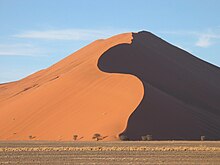Draa (dune)

Under Draa dunes ( arab. Arm), also inland dunes or Compound dunes called, are in the geomorphology very large dunes understood. The Draa are likely to be prehistoric forms from the Pleistocene .
etymology
Draa dunes are derived from the Arabic درأ ( Draa ) meaning arm .
definition
Draa are aeolian transport bodies of the first order, which are defined by an interdune distance of more than 300/500 meters and heights of 20 to 450 meters. They can be of transverse or longitudinal origin. To them, all large dunes with overlay forms include ( English superimposed bedforms ), including "complex dune forms" and "composite dune forms '' ( English compound dunes ), such as star dunes (Rhourd-Draa). Their characteristic relaxation time (ie the time required to adapt to changing wind conditions) is thousands of years.
description
Due to their stable ridges, the Draa are relatively stationary in contrast to shifting dunes. At first they form like smaller leeward dunes (leeward is the side facing away from the wind), but then, as overlapping forms, they can reach heights of up to 450 meters and an extension of 1,000 meters ridge length. Their inclination is about 20 ° both upwind and leeward. Draa can be overlaid by various types of dunes, such as B. from Aklé or sickle dunes . Some Draa can develop slip faces up to 50 meters high . Sliding slopes can also be completely absent, as is the case with Draa, whose windward and lee side are crossed by dunes. In the grain size-wavelength diagram, Draa clearly stand out from simply structured dunes and ripples due to their increased wavelengths. Their grain sizes are on average smaller than those of dunes and ripples and remain below 0.6 millimeters.
Internal structure
Because of their composite shape, Draa have a rather complicated internal structure. Their oblique stratification bodies are separated by various orders of discordances , which can be of either erosion or accumulation-related nature. These interfaces, known as bounding surfaces , show angles of incidence that are inclined both against and with the wind.
Emergence
Draa takes a long time to form. The prerequisite for the formation is a continuously blowing wind with a speed of at least 36 km / h. It also depends on a sufficient supply of sand to be able to form the core of the structure.
The Taylor-Görtler model is used to explain their origin , according to which horizontal wind spirals form wind rolls directed against one another ( roller vortices ), which continuously throw up the sand.
Occurrence
In contrast to other types of dunes, Draa occur only in the large sandy areas of the earth, especially in the ergs of the Sahara. The Namib has the largest Draa in the world because there are ideal conditions in terms of wind and material.
Occurrence in detail:
- Abu Dhabi - Trucial Coast
-
Namibia
- Namib
- Sahara
- Grand Erg Oriental
- Murzuk, Libya
Draa are also known from geological history, such as the Seif-Draa of the Yellow Sands from the Lower Permian north-east of England . In Arran-basin of the Permian of western Scotland also Draa occur.
literature
- Frank Ahnert: Introduction to Geomorphology. UTB, Stuttgart 2003, ISBN 3-8252-8103-5 .
- Helga Besler: The dunes - Namib: Development and dynamics of an erg. Stuttgart 1980, ISBN 3-88028-096-7 .
- Roland Baumhauer: Physical geography. Volume 1: Geomorphology. Knowledge Buchges., Darmstadt 2006, ISBN 3-534-15635-8 .
Web links
- Website of the Enzyclopaedia Britannica
- Henning Engeln: Dunes: The Laws of Sand: The Riddle of the Mega Dunes. In: GEOkompakt No. 12 - The desert. September 2007.
Individual evidence
- ^ Nicholas Lancaster: Dune Morphology and Dynamics. In: Anthony J. Parsons, Athol D. Abrahams (Eds.): Geomorphology of Desert Environments. Springer, 2009, ISBN 978-1-4020-5719-9 , p. 557.
- ↑ G. Kocurek: Significance of interdune deposits and bounding surfaces in aeolian dune sands . In: Sedimentology . tape 28 , 1981, pp. 753-780 .
- ^ A b I. G. Wilson: Aeolian bedforms - their development and origins . In: Sedimentology . tape 19 , 1972, p. 173-210 .
- ^ JRL Allen: Reaction, relaxation and lag in natural sedimentary systems: general principles, examples and lessons . In: Earth Science Reviews . tape 10 , 1974, p. 263-342 .
- ↑ dune. ( Memento of the original from September 30, 2013 in the Internet Archive ) Info: The archive link was inserted automatically and has not yet been checked. Please check the original and archive link according to the instructions and then remove this notice. Geoglossar.com, online glossary of geosciences.
- ^ Helge Haacke: Dunes. ( Memento of the original from March 4, 2016 in the Internet Archive ) Info: The archive link was inserted automatically and has not yet been checked. Please check the original and archive link according to the instructions and then remove this notice. (PDF; 227 kB) Sub-Seminar Geomorphology, winter semester 2001/2002, Geographical Institute Kiel.
- ^ M. Leeder: Sedimentology and Sedimentary Basins . Blackwell Science, Oxford 1999, ISBN 0-632-04976-6 .
- ↑ CS Bristow, J. Pugh, T. Goodall: Internal structure of aeolian dunes in Abu Dhabi determined using ground-penetrating radar . In: Sedimentology . tape 43 , 1996, pp. 995-1003 .
- ↑ RP Steele: Longitudinal draa in the Permian Yellow Sands of north-east England . In: Developments in Sedimentology . tape 47 , 1983, p. 484-489 .
- ↑ LB Clemmensen, K. Abrahamsen: Aeolian stratification and facies association in desert sediments, Arran basin (Permian) Scotland . In: Sedimentology . tape 30 , 1983, pp. 311-339 .
